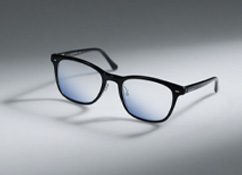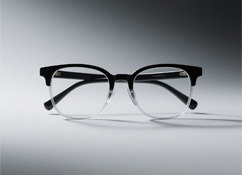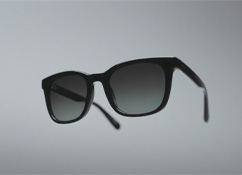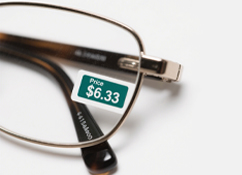Whether you’re shopping for new glasses, repairing an old pair, or simply curious about how your frames work, understanding the components of eyeglass frames is key to finding a comfortable, functional, and stylish fit. A standard pair of eyeglasses combines main structural parts (like lens rims and temples) with smaller functional parts (like hinges and nose pad screws)—each playing a critical role in comfort, durability, and aesthetics. Let’s break down every part and material in detail.
Lens rims are the outer edges that hold your prescription lenses in place. They use metal wires, nylon threads, or screws to secure lenses via grooves (for full - rim frames) or drilled holes (for rimless/semi - rimless styles). Beyond function, lens rims define your frame’s look—from classic full - rim to sleek rimless designs.
- Full - Rim: Encloses the entire lens, offering maximum support for strong prescriptions. Ideal for bold, statement frames.
- Semi - Rimless: Only covers the top or bottom of the lens (often held by a nylon thread). Lightweight and modern.
- Rimless: No rims—lenses are attached directly to the bridge and temples. Sleek, minimalist, but less durable for heavy lenses.
The bridge links the left and right lens rims (or attaches directly to lenses in rimless frames). It’s the part that rests on your nose, so its shape and size directly impact how your frames stay in place.
- Keyhole Bridge: Curved like a keyhole, it distributes weight evenly across the nose—great for narrow or high - bridged noses.
- Saddle Bridge: Flat and wide, it fits broader noses and prevents slipping.
- Padded Bridge: Has a soft cushion to reduce pressure marks on sensitive skin.

Nose pads are small, soft pieces that sit directly on your nose, supporting the frame and preventing it from sliding down. They typically include three parts: nose pad arms (attach to the frame), nose pad boxes (hold the pad), and the pad itself (contacts your skin).
- Silicone: The most common—soft, non - slip, and hypoallergenic (ideal for sensitive skin).
- PVC: Firm and affordable, but less comfortable for long wear.
- Adjustable: Can be bent or tilted to fit irregular nose shapes (a game - changer for custom comfort).
End pieces are the curved or angled parts that connect the lens rims to the temples. They’re usually made of metal or plastic and designed to flex slightly—absorbing shock when you put on/take off your glasses.
Temples (also called “arms”) are the long pieces that hook over your ears, holding the frame in place. They’re adjustable to fit different head sizes and come in various styles to match your look.
- Straight Temples: Classic and simple, fitting most ear shapes.
- Curved Temples: Contoured to hug the back of your ears—ideal for active lifestyles.
- Keyhole Temples: Feature a cutout (like a keyhole) for a sleek, modern vibe.
Hinges are the joints that connect the end pieces to the temples, allowing your frames to fold for storage. They’re one of the most critical parts—poor - quality hinges can lead to broken temples or loose frames.
- Spring Hinges: Flexible and shock - resistant, they prevent breakage if you accidentally bend your temples.
- Barrel Hinges: Traditional and durable, using a series of “barrels” (cylinders) held together by a screw.
- Hidden Hinges: Sleek and modern, with no visible screws—common in rimless or minimalist frames.
The material of your frame affects its weight, durability, comfort, and style. Eyeglass frames are made from three main categories: natural materials, metals, and non - metals. Let’s compare each:
Historically, tortoise shell (from sea turtles) was used for high - end frames—known for its unique pattern and durability. Today, however, tortoise shell is illegal in most countries due to wildlife protection laws. Synthetic alternatives (like acetate with tortoise shell patterns) are now the norm.
Metal frames are durable and sleek, but their performance varies by type:
- Copper Alloys: Affordable but prone to tarnishing over time.
- Nickel Alloys: Cheap and lightweight, but may cause allergic reactions in 10–15% of users.
- Titanium: The gold standard for comfort—ultra - lightweight, corrosion - resistant, and hypoallergenic (perfect for sensitive skin).
- Stainless Steel: Durable, rust - resistant, and budget - friendly—great for everyday wear.
Non - metal (plastic) frames are the most popular today—offering flexibility, color variety, and comfort. Common types include:
Cellulose acetate is the most popular non - metal material—and it’s made in two ways:
- Sheet Acetate Frames: Cut from large sheets of acetate, allowing for unique patterns and thick edges. Perfect for bold, custom styles.
- Injection - Molded Acetate Frames: Made by melting acetate pellets and injecting the liquid into molds. More consistent in shape, thinner, and mass - produced—ideal for everyday wear.
By understanding each part of an eyeglass frame and material option, you can choose glasses that fit your face, lifestyle, and budget. Whether you prioritize comfort (titanium frames with silicone nose pads) or style (vibrant acetate full - rim frames), every component plays a role in your final choice.











